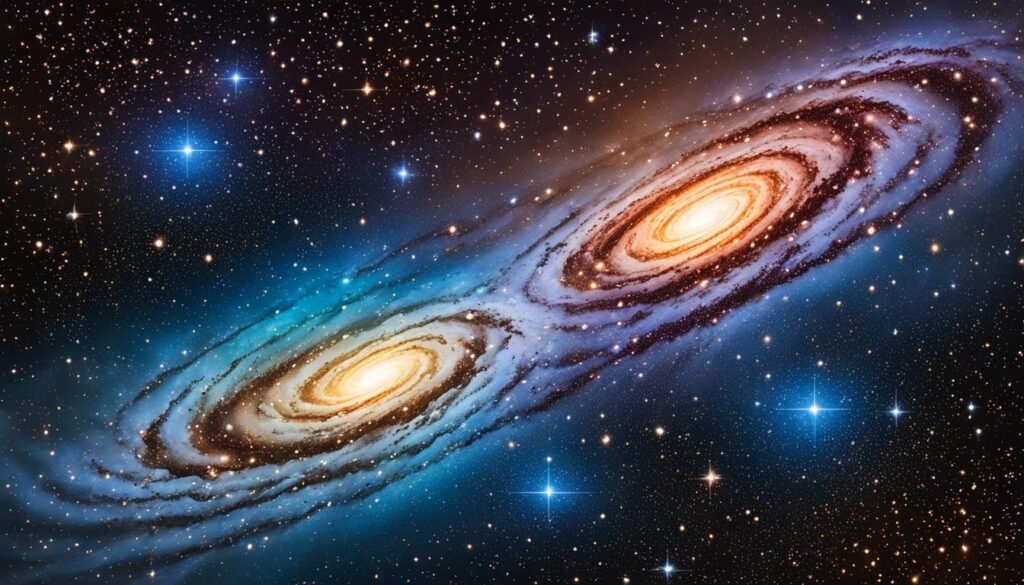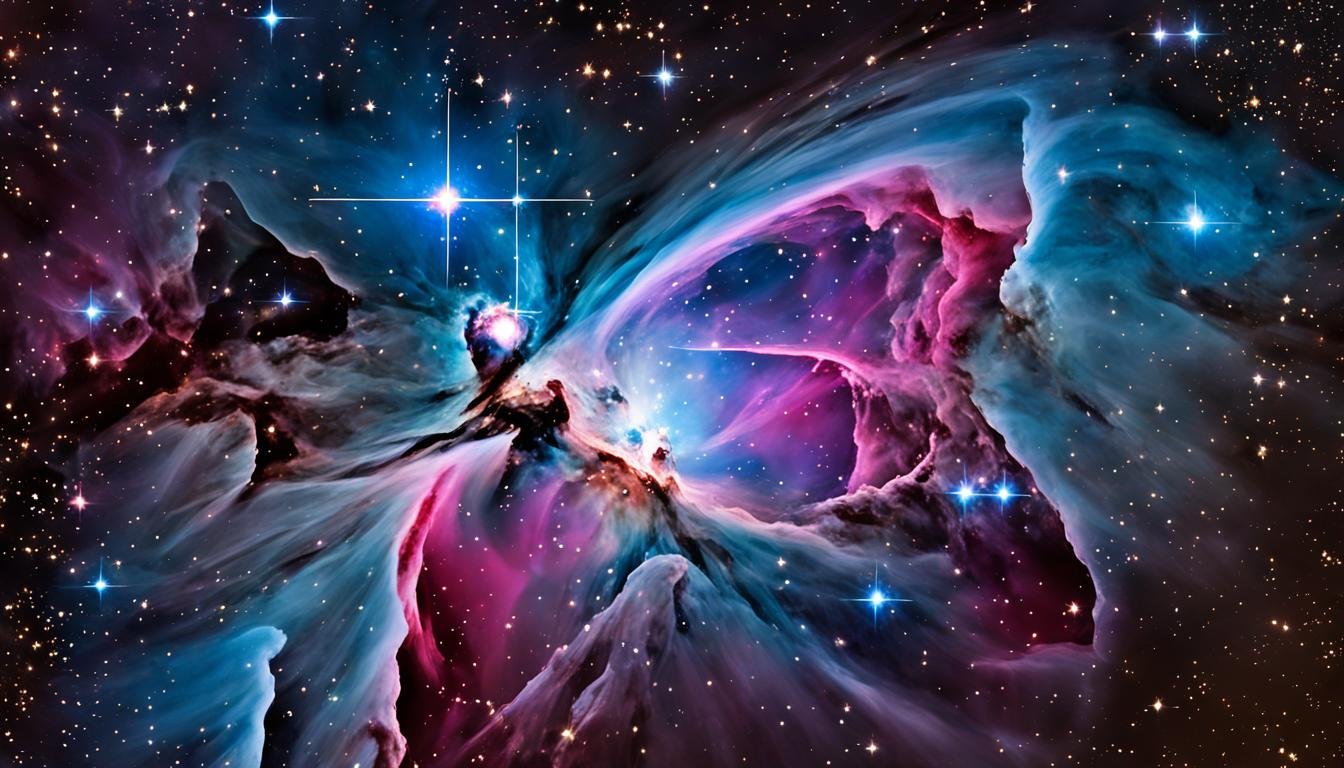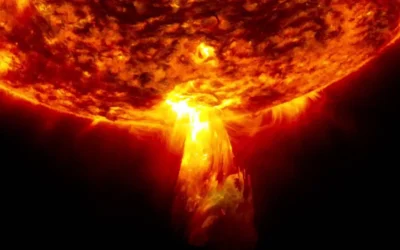As you gaze up into the tapestry of the night sky, you’ll find within the constellation of Orion, a stellar nursery of staggering beauty and cosmic significance—the Trapezium Cluster. This magnificent constellation houses a formative collective of stars that shed light on the mysteries of star formation. Located in the heart of the Orion Nebula, the Trapezium Cluster stands as a pivotal site in the arena of astronomy, offering insights into the vibrant processes that shape celestial bodies.
Amid the swirling clouds of gas and dust, this young cluster emerges as a beacon of discovery, inviting you to delve into its depths. The cluster originated from the nebula itself, a dazzling phenomenon where new stars are born and ignite to illuminate their stellar cradle. It’s a place where you can witness the infancy of massive stars, whose gravitational bonds pull them into a dance that spans millennia—a dance you are only just beginning to understand.
Key Takeaways about the Trapezium Cluster
- Explore the heart of the Orion Nebula—the Trapezium Cluster, an open cluster of young stars that offers a window into ongoing star birth.
- Witness the radiant power of this star cluster, with its central stars dramatically influencing the surrounding nebula’s appearance and structure.
- Discover the heritage of the cluster that dates back to 1617 when the first stars were chronicled by one of the great pioneers of modern astronomy.
- Use a moderate telescope to observe the six primary stars of the cluster, each revealing facets of early stellar evolution.
- Understand how the Trapezium Cluster acts as a natural laboratory, allowing astronomers to study star formation in unprecedented detail.
Unveiling the Trapezium Cluster: A Starry Heart in Orion
As we delve into the heart of the Orion constellation, the Trapezium Cluster emerges as a monumental beacon in the field of astronomical observations. Once sketched by the pioneering eyes of Galileo Galilei, the cluster’s discovery laid the groundwork for centuries of celestial discovery and research.
Galileo’s Historic Discovery
In the annals of astronomy, Galileo Galilei’s contributions are foundational. His fascination with the heavens brought forth the initial identification of the Trapezium Cluster. Armed with his rudimentary but revolutionary telescopes, Galileo documented three of the luminaries that compose this quartet, a cornerstone formation within the grander star cluster. His meticulous sketches, however, missed capturing the diffuse elegance of the Orion Nebula—a vast cosmic canvas that holds the cluster in its embrace.
A Glimpse Through Telescopes: Revealing the Cluster’s Stars
The advancement of telescopic technology has deepened our comprehension of the Trapezium Cluster far beyond Galileo’s time. Once seen as a speckled trio, the addition of a fourth star in 1673 fleshed out the cluster’s iconic configuration. Today, modern telescopes unveil the Trapezium Cluster in magnificent detail. Infrared imaging, transcending the limitations of visible spectra, penetrates interstellar dust to disclose the cluster’s many hidden stars.
With high-powered telescopes and infrared light, enthusiasts engage in their own star identification, mapping the binary rhythms in the celestial dance. Stars A, B, and C are particularly noteworthy, entwining in an eclipsing binary ballet—each pass a disappearing act that is predictable, mesmerizing, and symbolizes the pulsating nature of our universe.
The Hubble Space Telescope, a titan among our observational arsenals, captures both the intricate complexity of the Trapezium’s individual stars, and the grand tapestry of the surrounding nebula with unparalleled clarity. These observations enable an intimate look into the interplay of light and gravity, guiding your understanding of Trapezium star identification.
Here’s an invitation to marvel at the data that present a glimpse into our cosmic Neolithic—key astronomical findings about the four primary stars of the Trapezium Cluster:
| Star Label | Right Ascension | Eclipsing Binary Status |
|---|---|---|
| Theta1 Orionis A | 05h 35m 15.82s | Yes, varies over 65 days |
| Theta1 Orionis B | 05h 35m 16.11s | Yes, varies over 6 days |
| Theta1 Orionis C | 05h 35m 16.47s | Most luminous, not an eclipsing binary |
| Theta1 Orionis D | 05h 35m 17.30s | Not identified as an eclipsing binary |
Your journey through the cosmos is enriched by the legacy of pioneers and the relentless march of technology. Now go forth, with Galileo’s spirit as your muse, and behold the Trapezium Cluster—a stellar beacon in the tapestry of the night.
Exploring the Origins of the Trapezium Cluster: A Young Stellar Family
Delving into the heart of the Orion Nebula, you are witnessing the cradle of star birth, where young stars cast their nascent glow across space. The Trapezium Cluster stands out as a stellar siblinghood, showcasing the very origins of star formation within this magnificent stellar nursery. With its origins rooted in the rich gases of the Orion Nebula, this cluster presents an unparalleled view of cosmic youth and the intricate details of stellar dynamics.
Each star within the cluster wheeling around its kin, marks this as a prime example of stellar dynamics playing a crucial role in the life of a young star cluster. These stars illustrate what can be depicted as nothing less than a cosmic dance—held together and choreographed by gravitation as they share their earliest moments of existence.
The brightest members, behemoths in their own right with masses far exceeding that of our Sun, command the gravitational arena, influencing the cluster’s overall structure and development. Their interplay is vital to the apparent makeup of the Trapezium Cluster, affecting how we observe and interact with these young stars from our distant vantage point on Earth.
The youthful stars of the Trapezium Cluster—mere hundreds of thousands of years old—offer a rare glimpse into the earliest chapters of stellar evolution.
These stars’ early formation stages, viewed against the backdrop of one of the most studied regions in the night sky—the Orion Nebula—offer invaluable insights into the Trapezium Cluster origins, as well as the broader mechanisms at play in the universe’s continually unfolding story.
The Luminous Quartet: Understanding the Core Stars
Delving into the heart of the Trapezium Cluster reveals a spectacle of stellar brilliance and complexity. At the core of this assembly, the stars of the Luminous Quartet command our attention, and among them stands the radiant Theta1 Orionis C—a paragon of luminous stars. As explorers of the cosmos, you’ll find that these celestial titans are not only luminous but also dynamic, participating in a cosmic dance as they bind themselves in binary partnerships. Below, uncover the details that define these luminaries, from their stellar classifications to their singularities as eclipsing binaries and Algol-type variables.
The Splendid Theta1 Orionis C
Recognized for its sheer luminosity and mass, Theta1 Orionis C burns with an intensity unrivaled within its stellar family. As O-type stars go, it’s an unparalleled beacon, with speculations suggesting this entity alone illuminates a significant portion of the Orion Nebula. When you gaze at the night sky, you are witnessing a star that dwarfs our own Sun, yielding clues to the behavior of the cosmos’ most extraordinary entities.
The Eclipsing Binaries: A and B Components
Eclipsing binary stars within the Trapezium Cluster offer a dramatic example of celestial mechanics. Stars classified as Algol-type variables provide astrophysical insights into stellar evolution—a captivating chapter in the narrative of the cosmos. Both Theta1 Orionis A and B weave an intricate light pattern as they periodically conceal each other, creating fluctuations in brightness that astute observers can track and analyze.
| Star Name | Magnitude Variation | Period (days) | Classification |
|---|---|---|---|
| Theta1 Orionis A (V1016 Orionis) | 6.73 to 7.53 | 65.4325 | Algol-type Eclipsing Binary |
| Theta1 Orionis B (BM Orionis) | 7.95 to 8.52 | 6.4705 | Algol-type Eclipsing Binary |
The table above illustrates the celestial mechanics at play, displaying their magnitude range and periodicity. Algol-type variables, such as Theta1 Orionis A and B, offer a unique opportunity to study the transfer of mass and energy in binary systems. This knowledge enhances your understanding of the evolution and lifetime of massive stars.
Astronomy in Focus: Infrared Insights and X-ray Illuminations
As you delve into the mysteries of stellar creation, infrared imaging and X-ray astronomy serve as your eyes, piercing through cosmic dust to unveil the wonders of the Universe. Recent advancements in these technologies are reshaping our understanding of celestial phenomena and the lifecycle of stars, providing a glimpse into the fundamental processes of planetary formation within circumstellar disks.
Infrared Imaging’s Revelations
The power of infrared imaging is evident as it reveals hidden members of the Orion Nebula’s youthful Trapezium Cluster. With the ability to detect cooler objects that escape the gaze of traditional optical telescopes, infrared astronomy brings into light the nuanced composition of these stellar ensembles, exposing the proliferation of brown dwarfs and runaway stars. It’s within these observations that the potential for future worlds comes to focus—nearly half of these stars are encircled by circumstellar disks, the breeding grounds for new planets.

X-ray Views from Chandra: A Celestial Powerhouse
The Chandra X-ray Observatory, a titan of X-ray astronomy, gifts us with insights into the high-energy dynamics of star clusters. X-rays emanating from the vibrant cores of OB stars within the Trapezium Cluster punctuate the canvas of the Orion Nebula. We come to recognize that these stars are not mere points of light but immense generators of radiance and activity, each playing a pivotal role in the luminosity and lifecycle of the nebula. This celestial powerhouse, under Chandra’s vigilant watch, continues to demystify the energetic interactions at the heart of star formation.
The Intersection of Stellar Dynamics and Potential Black Holes
As you delve deeper into the cosmos, the Trapezium Cluster emerges as a pivotal lab for examining the mysteries of stellar dynamics. This cluster’s dense concentration of stars offers an ideal environment for cutting-edge research, especially when exploring the behavior of celestial bodies under the influence of potent gravitational forces. Understanding how stars interact within such dense environments contributes significantly to our knowledge of galactic formations and evolutions.
The Enigma of the Intermediate-Mass Black Hole
In the heart of the Trapezium Cluster, scientists theorize the presence of an intermediate-mass black hole—a colossus lurking unseen. The potential discovery of such an entity could explicate the high velocity dispersion measured among the cluster’s stars, unveiling the inner workings of their collective movements. If this celestial heavyweight actually resides within the cluster, it would mark a significant milestone in the study of stellar dynamics and enrich our comprehension of black hole categorization.
| Attribute | Observational Significance |
|---|---|
| Velocity Dispersion | High dispersion suggests a significant mass influencing stellar movements. |
| Black Hole Mass | An intermediate-mass black hole fills the gap between stellar-sized and supermassive black holes. |
| Stellar Dynamics | Indicates how stars within the cluster are influenced by one another and gravitational forces. |
Should observations confirm the existence of an intermediate-mass black hole, it could revamp the trajectory of our cosmic understanding, drawing us closer to the enigma that is the universe. Such research steers us toward piecing together the grand puzzle of how galaxies evolve—and your gaze at the night sky could hold the key to untangling these celestial secrets.
Substellar Companions: Brown Dwarfs and Runaway Stars in the Cluster
When you gaze upon the Trapezium Cluster, you’re not only looking at a cradle of massive stellar giants but also at a congregation of enigmatic, elusive inhabitants known as brown dwarfs and runaway stars. These fascinating substellar objects represent a critical component of the cluster’s dynamic life and celestial activities.

Brown dwarfs, often dubbed ‘failed stars’, are particularly intriguing because they occupy the celestial grey area between the largest planets and the smallest stars. With masses too slight to initiate the fusion of hydrogen into helium—the defining process of stellar life—they glow faintly with the heat of their own formation, offering a glimpse into the variety of forms that celestial objects can take.
In contrast, runaway stars are recognized by their high velocities, a characteristic that hints at violent past events within the cluster. Perhaps they’ve been gravitationally slingshotted out of orbit by interactions with other massive bodies, or they’ve witnessed the explosive death of a binary partner. These dramas of galactic dimension underscore the intense forces and interactions at play in star-forming regions.
Let’s take a closer look at the data gathered from these fascinating celestial bodies:
| Brown Dwarf Characteristics | Runaway Star Traits |
|---|---|
| Lacking sufficient mass for hydrogen fusion | Escaping the cluster at high velocities |
| Temperatures cooler than most stars | Paths hinting at powerful dynamic interactions |
| Emit primarily in the infrared spectrum | Possibly ejected by supernovae or binary interactions |
| Bridge gap between largest planets and smallest stars | Inform our understanding of cluster dynamics |
As you explore the depths of the cosmos, the existence of brown dwarfs and runaway stars in the Trapezium Cluster offers a powerful testament to the diversity and complexity of our universe. Their study not only enriches our comprehension of substellar phenomena but also sheds light on the gravitational intricacies that govern the evolution of clusters themselves.
The Broader Celestial Context: The Trapezium’s Role in the Orion Complex
As your gaze ascends to the night sky, the stars of the Orion Nebula Cluster dazzle as a testament to the palpable threads that weave the vast tapestry of our universe. You are looking at an extensive star grouping that not only illuminates the celestial context at large but also houses a particularly significant sub-group – the Trapezium Cluster. Its influence extends through the gaseous clouds, bearing upon the stellar cradle where these celestial marvels are born.
In the grander scheme of astrological frameworks, the Orion Nebula Cluster emerges not just as an assembly but as a dynamic community of roughly 2,000 stars spread across 20 light-years. It’s as if you can unravel the mysteries of star formation and celestial dynamics simply by contemplating this extensive gathering of suns.
The Extensive Orion Nebula Cluster
Envisaging the Orion Nebula Cluster as an orchestra, each star contributes a unique note to the harmonious composition that reverberates through the cosmic expanse. This cluster furnishes a perfect milieu to comprehend the intricate nature of celestial births and cluster dynamics, urging us to reflect on the broader astronomical significance the Trapezium Cluster holds within.
| Feature | Orion Nebula Cluster | Trapezium Cluster |
|---|---|---|
| Number of Stars | ~2,000 | ~500 |
| Diameter | ~20 light-years | ~1.5 light-years |
| Average Age | ~1 million years | ~300,000 years |
| Notable Stars | Various spectral types | Brightest members of Theta1 Orionis |
| Role in Astronomy | Key area for stellar birth research | Ionizing source for the Orion Nebula |
Cosmic Crucibles: Circumstellar Disks and the Seeds of Planet Formation
Within the heart of the Trapezium Cluster, you witness the dazzling spectacle of **stellar evolution** in its primal stage—here, countless celestial bodies verge on birthing new worlds. These **circumstellar disks**, pervasive throughout the cluster, are the astrophysical artisanal shops from which solar systems emerge. Teeming with gas, dust, and detritus, these disks encapsulate the raw materials destined to coalesce into planets, moons, and other cosmic structures. As you delve deeper into the unfettered chaos whence planets spring forth, you stand on the observational frontier where the mysteries of planetary genesis unfold.
Their existence around nearly half the cluster’s stars positions **circumstellar disks** not merely as astronomical occurrences but as vigorous participants in the narrative of cosmic creation, sparking the transition from stellar adolescence to mature solar systems. Within these swirling **cosmic crucibles**, matter follows the inexorable pull of gravity to sculpt a diversity of planetary forms—a testament to the universal principles presiding over **planet formation**. The dynamism enclosed within these vast accumulations of cosmic matter ensures that, even now, the narrative of celestial generation is actively etched across the canvas of outer space.
Aligning your sights on the Trapezium Cluster is akin to gazing into the crucible of cosmic potency, where the early chapters of **stellar evolution** are inked into existence. The discoveries garnered here serve as foundational elements for our comprehension of the universe’s architectural rhythms. Hence, through unwavering vigilance in observation, the Trapezium Cluster could soon disclose further secrets, heralding a new epoch in our grasp of the majestic processes that dictate the evolution of stars and the genesis of planets, illuminating our place within the entwined tapestry of existence.
FAQ
What is the Trapezium Cluster?
The Trapezium Cluster is a compact group of young stars located in the heart of the Orion Nebula, which is a prominent stellar nursery. It’s noted for being a site of active star formation and consists of several massive, luminous stars that illuminate the surrounding nebula.
Who discovered the Trapezium Cluster and when?
Galileo Galilei made the initial discovery of what would later be known as the Trapezium Cluster on February 4, 1617. However, he only sketched three of the stars and did not observe the nebulosity of the Orion Nebula surrounding them.
Can amateur astronomers observe the Trapezium Cluster?
Yes, amateur astronomers can observe the Trapezium Cluster using telescopes with around a 5-inch aperture under good seeing conditions. This allows them to resolve some of the individual stars in the cluster, including some of the binary systems.
What type of stars can be found in the Trapezium Cluster?
The Trapezium Cluster contains massive, young stars that are many times larger than the Sun, including the bright Theta1 Orionis C. Infrared observations have also revealed brown dwarfs and low-mass stars within the cluster.
Why is Theta1 Orionis C significant?
Theta1 Orionis C is significant because it’s the brightest and most massive star within the Trapezium Cluster. With an apparent magnitude of 5.13 and an O-type classification, it outshines the Sun by 251,000 times and is recognized as a close binary system, providing valuable insights into the nature of massive stars.
Are there any eclipsing binaries in the Trapezium Cluster?
Yes, the components A and B of the cluster are known Algol-type eclipsing binaries. These stars orbit each other in such a way that they periodically eclipse one another, leading to regular changes in their apparent brightness as seen from Earth.
How do infrared imaging and X-ray observations contribute to our understanding of the Trapezium Cluster?
Infrared imaging penetrates the surrounding dust clouds, revealing more stars, brown dwarfs, and circumstellar disks in the cluster, while X-ray observations from the Chandra X-ray Observatory showcase the high-energy processes and help in understanding the roles of massive OB stars in the cluster’s radiance.
Is there a black hole in the Trapezium Cluster?
The existence of an intermediate-mass black hole within the Trapezium Cluster is currently a theory under investigation, driven by the high velocity dispersion among the cluster’s stars. If confirmed, it could have significant implications for our understanding of black holes and stellar dynamics.
What is the role of brown dwarfs and runaway stars in the Trapezium Cluster?
Brown dwarfs and runaway stars within the cluster help astronomers study complex gravitational interactions in such dense star-forming regions and expand our knowledge of the types of objects that can form in stellar clusters.
How does the Trapezium Cluster relate to the larger Orion Nebula Cluster?
The Trapezium Cluster is a sub-group within the larger Orion Nebula Cluster, which contains around 2,000 stars. It plays a crucial role in the star formation activity and dynamics of the Orion Complex.
Why are circumstellar disks important for the study of planet formation?
Circumstellar disks around stars in the Trapezium Cluster are important because they contain the gas, dust, and debris that could potentially coalesce to form planets. Studying these disks can provide invaluable insights into the processes of planetary system formation and evolution.






